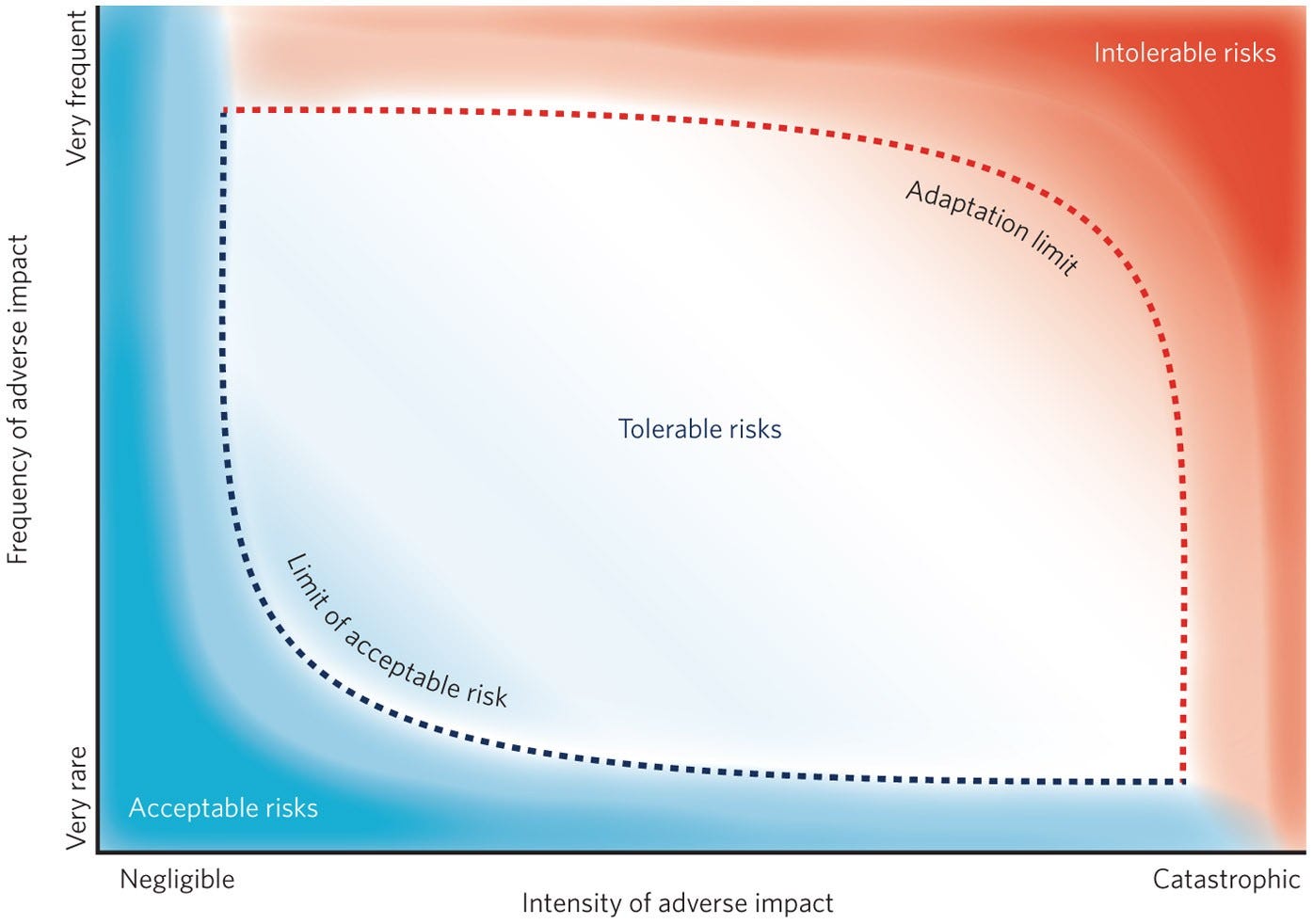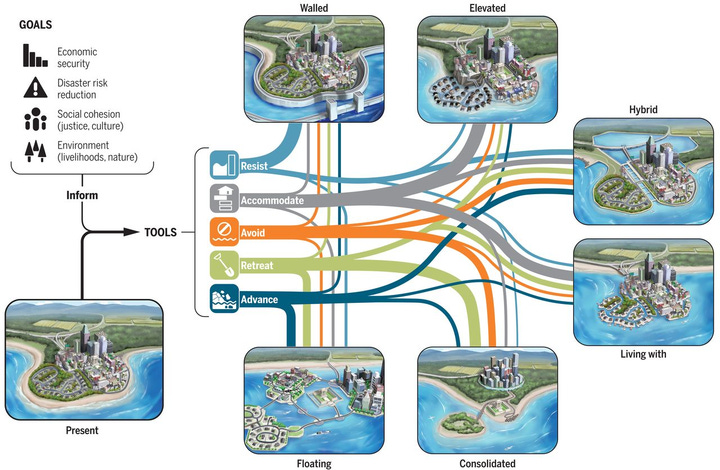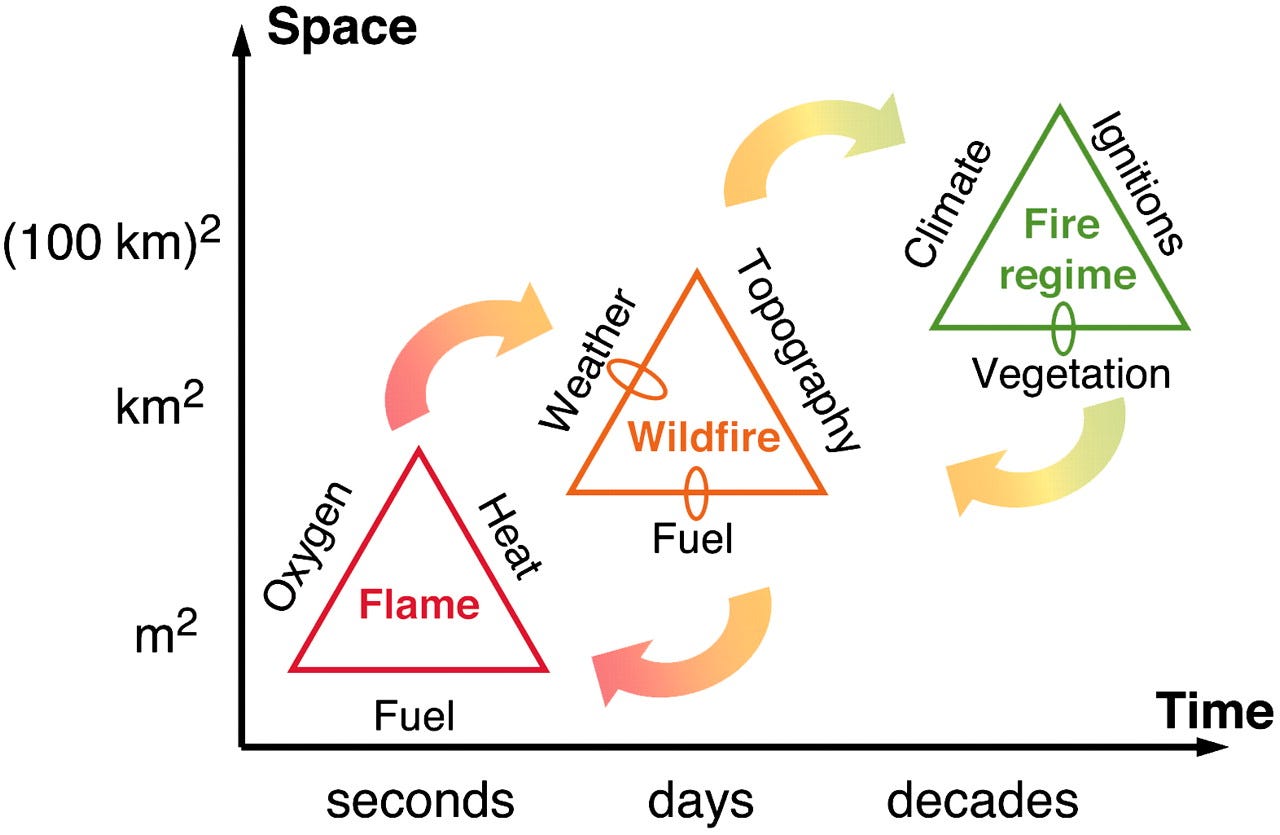TL;DR
There’s no climate market thesis without science
If mitigation’s north star is greenhouse gas reduction, adaptation’s is risk management
Proximity to hazards is what pays
Managed retreat is fascinating but far off
Can someone make a domain-specific language for climate adaptation?
Climate adaptation tech is the new new thing. In working towards an adaptation thesis, I’ve read broadly the past six weeks. January and February’s reading surfaced a few thoughts on the space, detailed below.
Science-first theses
Climate market theses must stack up against the underlying science. VCs must be able to explain how their portcos meaningfully move the needle in the real-world. Lowercarbon’s Ryan Orbuch touched on this in a recent podcast, where he emphasised the importance of transactions in carbon markets clearly mapping to changes in the carbon cycle:
…not to actually understand the actual carbon cycle. Which is nominally the whole premise of paying anyone to do an offset or removal, is you're paying them to do something to the carbon cycle…
A [carbon removal] methodology should be a wrapper over the actual carbon cycle process on Earth.
While this was said in the context of the carbon credits market, Ryan captured the crux of the issue. That beneath the layers of data and software and business, exist real-world phenomena we are trying to change. If our theory of change of those phenomena is faulty, we cannot expect our market theses to hold up over time.
This is just as critical in adaptation. For example, fireTech solutions must be grounded in the science of fire ecology - partly illustrated below.
Each triangle represents critical wildfire factors at increasing time and space scales; while heat is critical to initiate combustion(flame), wind and topography influence how a fire grows(wildfire), and longer-term wind and vegetation patterns explain wildfire recurrence over decades(fire regime). The small loops represent feedback between fire and a given factor, such as the influence of fire on vegetation distribution.
Once you have a scientific foundation, market frameworks can be layered on top - such as Convective Capital’s framing of fireTech solutions into three categories: fuel management, community resilience, and suppression.
It is up to VCs as much as it is up to founders to study these natural systems, and use them to inform investments. Consuming science and grounding your business thinking in science will also make you a better overall thinker - win/win.
The role of risk
All problems in mitigation are about the carbon cycle. Mitigation solutions, be it EVs or carbon removal, all try to manipulate some part of that cycle. Another way of expressing this is that all solutions can be gauged by their effect on greenhouses gases. In this sense, mitigation’s problem and solution spaces are homogenous.
In contrast, adaptation is heterogeneous. There is no unifying phenomenon like the carbon cycle. Wildfires, floods, and heat, to mention a few, are distinct problems requiring specialised solutions1. Additionally, adaptation lacks a physical, tangible stock akin to greenhouse gases. Each vertical has its own optimisation; in wildfire it’s minimising Annual Area Burned2, in waterTech it’s maintaining water supplies above a given threshold, in climateHealthTech it is minimising exposure to wet-bulb temperatures above 35 degrees Celsius. This lack of a shared physical stock such as greenhouse gases or an underlying phenomenon like the carbon cycle complicates having a comprehensive, birds-eye view on adaptation startups.
A way around this complication is abstraction. What is a concept that abstracts away adaptation’s disjoint threads, and allows us to compare disparate solutions? One such concept is risk. Risk is the shared stock that all adaptation solutions manipulate. 3D printed seawalls by Kind Designs reduce flood risk. IoT mesh networks like Dryad’s that smell wildfires before combustion reduce wildfire risk. Climate intelligence software such as Ladris facilitate thinking about risk, and can inform insurance contracts - which transfer risk to different stakeholders. If mitigation’s metric is greenhouse gas, adaptation’s is risk. If mitigation’s north star is greenhouse gas reduction, adaptation’s is risk management.
Is it possible to build a venture thesis in adaptation that revolves around climate risk? That’s a question for another article. I’ll leave you with a graph provided by the authors of Limits to Adaptation, that illustrates one way of thinking about risk in the context of adaptation; subdivided into acceptable, tolerable and intolerable ranges.

Proximity pays
Obvious but critical. Reducing adaptation risk requires specific solutions to specific hazards in specific locations. Coastal communities in Florida want and will pay for floodplain management software like Forerunner, not home wildfire protection services like Firemaps. The adaptation market will grow as climate change increases the proportion of the population in proximity to hazards. Proximity will correlate with willingness to pay.
We can expect this heterogeneity of localised, hazard-specific solutions to evolve over time. What were previously distinct solutions will consolidate into larger markets(e.g. floodplain management software merging with general urban planning), and what worked in one geography will find use in another.
Managed retreat
Managed retreat is the coordinated, official relocation of people and assets away from a hazard3. For example, after the Great Floods of 1993 in the midwestern US, the town of Valmeyer, Illinois relocated 3 km east, on land that is 91m higher than the floodplain4. It is a monumental task that stands to benefit from technological solutions: SaaS for coordination, hardware specialised in relocating physical assets, computer vision based evaluations of resettlement areas and damage, etc.

While an interesting space, it is too early for startups. Adaptation problems will affect humanity in a sequence: the problems of fighting hazards like rising sea levels and wildfires precede the problem of relocating people and assets. Climate risk will have to grow significantly before managed retreat, and tech solutions for it, become mainstream. It is a tough space, with lengthy legal battles, significant political risks, and no social precedent as of yet5. Additionally, just as Valmeyer was relocated with assistance from the federal government, funding and policy will need to be overhauled to prepare for a world where large scale relocations could become the norm. Parking managed retreat for now.
Accelerating the market
Natural language dominates the climate space. I see this in my day job at CUR8, where we work with numerous un/semi-structured documents conforming to diverse carbon removal standards. This complicates working in the carbon removal space, and is a broader issue across mitigation. We can expect this problem to be as pervasive in adaptation.
The software engineer in me yearns for a protocol. How would the market change if there was an open standard to express adaptation programmatically? A domain-specific language that can represent different hazards, geographies, and solutions. This would simplify the communication of complex adaptation specs, increase interoperability between disparate systems, and lower barriers to entry for engineers and entrepreneurs. Such a standard can accelerate market clock speeds by shortening iteration cycles, intensifying information flows, and increasing competition. There are numerous historical parallels for this; from Health Level Seven for health data to Git for version control.
Granted, programming is less ubiquitous in climate than say, biotech, but that is changing. Consider CarbonML, which is developing a “Carbon Messaging Global Standard” to express “declarations of embodied carbon in every product and service at all points & actors across supply chains”. As software eats harder and harder industries6 the switching cost from natural language to protocols will continue to shrink. Eventually this cost will pass some threshold, paving the way for industry specific protocols and the startups that advance them.
Or is this just a programmer’s pipedream? I don’t know.
Above are a few threads on my reading from the past six weeks. My fellow venture partner Austin Evarts said said that 2024 will be the year “climate adaptation goes mainstream as a climate venture capital theme”. I couldn’t agree more. Let’s build.
Recent readings
The emergence of heat and humidity too severe for human tolerance
Global non-linear effect of temperature on economic production
Limits to adaptation: Building an integrated research agenda
Special thanks to Karen Lee, Anay Shah, Ayodeji Okunlola, and Hayden Simmons for their contributions and feedback.
You can see this heterogeneity in the VC space, where hazard specific firms are emerging; Mazarine Ventures for waterTech and Convective Capital in fireTech.


